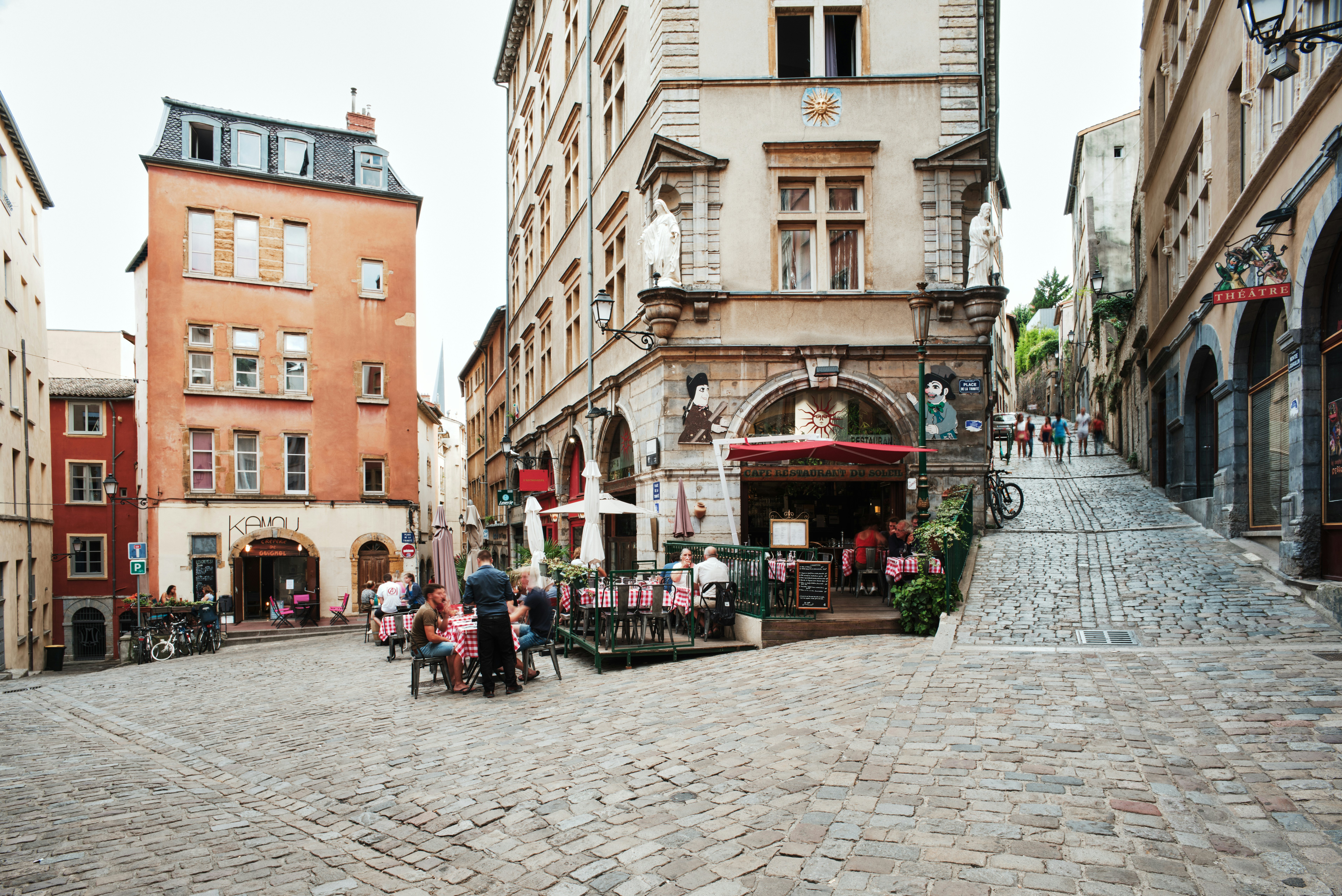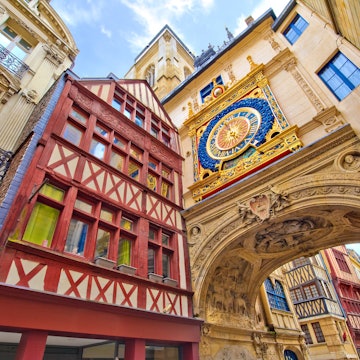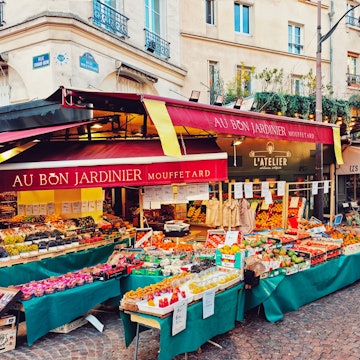

Gourmet appetites know no bounds in France. Here are our favorite food experiences in the country © Hernandez & Sorokina / Stocksy United
Food is at the heart of daily life in France. Markets overflow with seasonal produce, gourmet shops are ubiquitous, farms and artisan producers often welcome visitors, festivals celebrate local specialities, and dining spans from street-food snacks to rustic meals to rarefied haute cuisine.
Above all, eating in France is about savoring the experience. Here’s our top 10 of the very best, connecting you to the land, culture and traditions.

Soak up Lyon’s culinary heritage at a bouchon
Lyon is often dubbed France’s “gastronomic capital,” and you’ll see why when you visit a bouchon. These small, convivial bistros sprang up in the early 20th century, when wealthy households’ cooks, known as mères (mothers), set up their own homestyle premises with red-and-white-checked cloths covering closely packed tables.
Drawing on a thrifty nose-to-tail ethos, a classic bouchon meal might feature andouillette (pigs' intestine sausages), boudin noir aux pommes (blood sausage with apples), pieds de mouton/veau/couchon (sheep/calf/pig trotters), tablier de sapeur (breaded, fried tripe) or quenelles de brochet (pike dumplings in crayfish sauce). After a cheese course like cervelle de canut (fromage blanc with chives and garlic), finish with tarte aux pralines, made with crushed pink candied almonds.
Where to try it: Chez Hugon, Chez Paul, Le Garet and Café des Fédérations are long-standing bouchon favorites.
Unearth “black diamonds” in the Dordogne
In the Dordogne’s woodlands beneath oak and hazelnut trees, trained dogs sniff out elusive black Périgord truffles (Tuber melanosporum) that are traded at speciality markets during the midwinter season (December to mid-February) and star on local restaurant menus.
At the truffe (truffle) village of Sorges-et-Ligueux-en-Périgord, you can learn about the pungent fungi at the eco-museum, Écomusée de la Truffe, and walk in the truffle-producing woods along the Sentier des Truffières.
Where to try it: Join a truffle hunt (or out-of-season demonstration) at nearby Domaine Truffier de Saleix, followed by a tasting.

Sample snails in Burgundy
The escargot de Bourgogne (Burgundy snail) frequented Burgundy’s monk-tended vineyards, becoming a staple during Lent. Today you can taste gastropod mollusks at specialty grocers such as Hélice, L'Escargotier Beaunois, in Burgundy’s “wine capital” Beaune and restaurants throughout the region.
Snails are cooked in a bouillon and presented in shells stuffed with parsley, garlic and butter. Grasp the shells with special tongs and pry out the plump snails with a two-prong fork – then mop up the buttery puddle with chewy, freshly baked bread.
Where to try it: In season (generally May to September), you can see snails being raised at farms such as Autun’s L'Escargot Morvandiau, or catch August’s Fête de l'Escargot (snail festival) in Digoin.
Slurp oysters in the Languedoc
Several coastal locales are celebrated for moules (mussels) and huîtres (oysters). A lesser-known gem is the little village of Bouzigues in southwestern France’s Languedoc region. Cruising aboard the Bleu Marin, you can view the shellfish beds in the glinting Étang de Thau before enjoying them at waterside restaurants.
Where to try it: Around the lagoon at the nearby fishing port of Sète, dig into fresh-as-it-gets seafood at covered market Les Halles de Sète.
Warm up with melted cheese in the Alps
Lush alpine Savoie pastures provide the ideal environment for the prized cheeses – including five AOP (Appellations d'Origines Protégées) and three IGP (Indications Géographiques Protégées) – that are sold at fruitières (traditional mountain cheesemongers) and central to Savoyard menus.
Hearty dishes include fondue savoyarde, dipping skewered bread chunks into a burner-warmed pot melding stringy cheeses such as Emmentaler, Beaufort and Comté (plus dry white wine and garlic); raclette, “scraping” melting raclette cheese over boiled potatoes (with pickles to cut through the richness); and tartiflette, bubbling Reblochon cheese topping potatoes, lardons, onions and crème fraîche.
Where to try it: Learn more along the Route des Fromages de Savoie (Savoy Cheese Route), with museums, makers and tasting opportunities.
Snack on street-food specialities in Nice
Nice’s seaside climate is ideal for grazing. Start in the atmospheric old town, Vieux Nice, where you’ll find the vibrant Cours Saleya food and flower market.
Stalls, shops and tiny restaurants sell Niçoise specialities such as socca (chickpea-flour pancakes, served with pepper), tourte de blette (chard tart with raisins, pine nuts and parmesan), pissaladière (caramelized onion and anchovy tart), and pan bagnat (crusty tuna sandwich with boiled eggs, black olives and anchovies, drenched in green olive oil). Cool down with incredible ice cream flavors, like olive, fig and lavender, from Fenocchio.
Where to try it: Great snacking terrain extends around the boat-filled harbor Port Lympia. For the best piping-hot socca in all of Nice, don’t miss Chez Pipo.
Tuck in at Breton crêperies
Galettes and crêpes are a fixture of Brittany and its engaging former capital Nantes (now part of the Pays de la Loire region). These large, thin pancakes, expertly spread with a rozell (wooden rake) on a billig (cast-iron griddle), make an inexpensive, filling and informal meal – albeit always served on plates and eaten with a knife and fork, rather than rolled up to go as you might see elsewhere in France.
Begin with a savory galette, made using sarrasin or blé noir (buckwheat flour). The standard bearer is the galette complète with ham, cheese and egg typically miroir (fried and placed sunny-side-up in the center). Follow it up with a sweet crêpe made with froment (wheat flour); the pick of the toppings is caramel beurre salé (sticky caramel made with salted Breton butter). An earthenware bollée (bowl-like goblet) of low-alcohol, lightly effervescent Breton cidre (cider) makes the perfect accompaniment.
Where to try it: There are more than three dozen crêperies alone in Brittany’s present-day capital Rennes.
Devour pintxos in Biarritz
Encompassing southwestern France and neighboring northern Spain, the Basque Country is renowned for pintxos (Basque tapas), two-bite morsels balancing textures and flavors, many towering on small slices of baguette. Look out for creations featuring thinly sliced jambon de Bayonne (Bayonne ham), fiery-red Espelette chili peppers and sheep’s cheeses from the Pyrenees, and seafood such as anchovies, sardines, calamari and coquilles St-Jacques (scallops) from the Bay of Biscay.
Where to try it: The glitzy resort-meets-surfer magnet Biarritz is a fabulous place to enjoy pintxos with a glass of wine. Adjacent to the town’s aromatic covered market, stop in at Bar du Marché or Bar Jean.
Feast on bouillabaisse in Marseille
Ancient Mediterranean port city Marseille is famed for its fish stew of humble beginnings, now a high-end speciality.
Once a way for fisherfolk to cook up scraps left over from their catch, today bouillabaisse's secret is the quality of the fish – four or more different kinds, which are then deboned at your table and presented on a platter. The accompanying tomato-, saffron- and fennel-infused soupe de poisson (broth) comes with croutons, which you top with rouille (garlic-chili mayonnaise thickened with bread) and grated Gruyère cheese.
Where to try it: Avoid tourist-oriented restaurants cutting prices (and corners), and reserve ahead at venerable establishments like Chez Michel, Chez Fonfon or Le Rhul, or try a triple-Michelin-starred twist by Gérald Passedat at Le Petit Nice, one of the finest restaurants in France.

Take a cookery course in Paris
If you’re inspired to get into the kitchen, you can find classes all over the country. Many of the best and most convenient are in Paris, with durations from as little as a few hours and English instruction available.
Where to try it: Near the Eiffel Tower, the prestigious culinary school Le Cordon Bleu has professional courses as well as short programs and workshops unlocking the secrets of everything from breads to sauces and jus, as well as vegetarian cuisine.
Charming Montmartre is the location of Cook’n With Class, whose options include market shopping, and parent-child classes for families. In the Latin Quarter, Le Foodist has an array of classic French cookery and patisserie courses, as does La Cuisine Paris, in Le Marais, which also offers evening courses to create hors d’oeuvres and appetizers or French bistro dinners.
Vegetarians and vegans
Although France’s long-standing culinary traditions once meant few options for vegetarians and vegans, things have improved considerably during the last couple of decades. In larger towns, tourist centers, and cities such as Paris and Lyon, you’ll find numerous dedicated vegetarian and vegan establishments, and an increasing number of places creating innovative plant-based dishes.
Even in the biggest cities, however, not all restaurants offer vegetarian or vegan options, and menu changes aren’t always able to be accommodated. Be aware too that often small kitchens might not utilize separate pots, pans, and so on. Definitely check before booking.
In rural areas, vegetarian and, especially, vegan cuisine can be very thin on the ground – plan ahead to avoid getting caught out. Some local specialties such as crêpes in Brittany can be brilliant for vegetarians, while Nice’s specialty socca (chickpea-flour pancake) is a vegan favorite. Abundant fresh fruit and vegetables at local markets make self-catering in France a real treat.
Foods worth trying
Andouillette Big fat sausage made from minced pig intestine; try it in Troyes or Lyon, France’s gastronomic heart and known for its piggy cuisine.
Oursins (sea urchins) Caught and eaten west of Marseille in February.
Epoisses de Bourgogne Create a stink with France’s undisputed smelliest cheese from Burgundy.
Escargots (snails) Eat them in Burgundy, shells stuffed with garlic and parsley butter, and oven-baked.
Cuisses de grenouilles (frogs’ legs) Catching wild frogs and frog farming have been outlawed in France since 1980, but frogs’ legs are imported from Southeast Asia, ensuring this French culinary tradition is alive and kicking.
Foie (liver) Die-hard aficionados in the Dordogne eat fresh fattened duck or goose liver, raw and chilled, with a glass of sweet Monbazillac wine.
Pieds de cochon (pig trotters) Just that, or go for the oven-baked trotters of a mouton (sheep) or veau (calf).
Presskopf Alsatian head cheese or brawn, made with a calf or pig's head.
Beuchelle à la tourangelle Old-world dish from Tours in the Loire Valley, combining calf sweetbreads and kidneys with cream and mushrooms.
A year in food
Feasting happens year-round in France, and what’s cooking changes with the seasons.
Spring (March–May)
Markets burst with asparagus, artichokes and fresh goat’s cheese, Easter cooks up traditional lamb for lunch and the first strawberries redden.
Summer (June–August)
Melons, cherries, peaches, apricots, figs, garlic and tomatoes brighten markets. Breton shallots are hand-harvested, and on the coast, foodies gorge on seafood and shellfish.
Autumn (September–November)
The Camargue’s nutty red rice is harvested. Normandy apples go into France’s finest cider and chestnuts fall in the Ardèche, Cévennes and Corsica. Mushrooming and the game season begin.
Winter (December–February)
Nets are strung beneath silvery groves in Provence and Corsica to catch olives. Pungent markets in the Dordogne and Provence sell black truffles, and in the Alps, skiers dip into cheese fondue. Christmas means Champagne and oysters, foie gras, chestnut-stuffed turkey and yule logs.
















